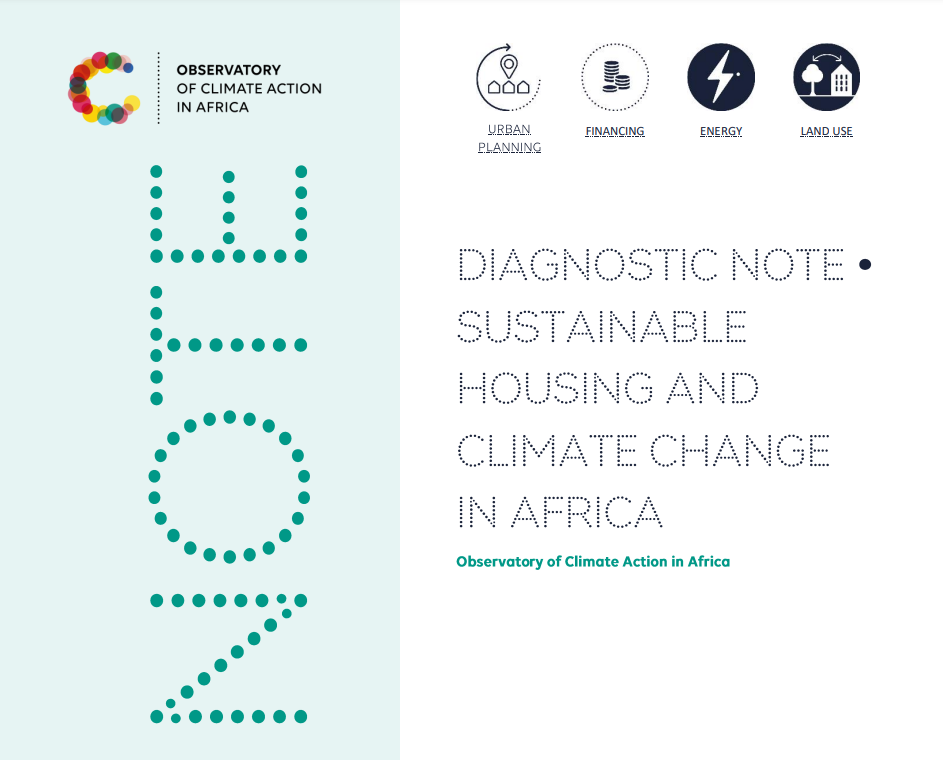Diagnostic note • Sustainable habitat and climate change in Africa
[October 2023] As part of the Climate Chance Africa 2023 Conference to be held in Yaoundé from October 23 to 24, 2023, the Observatory of Climate Action in Africa is carrying out a preliminary analysis of the main issues relating to the theme of "Sustainable habitat and climate change in Africa".

- Author: Mélaine Assè-Wassa Sama, Project Officer for Climate Action in Africa
- Date: October 2023, updated April 2024
- Summary
- Urban planning: a challenge for African cities exposed to climate change
- African cities struggle to mobilize financing
- Under-exploited traditional building materials and processes
- African cities face a major energy deficit
- Land governance at the heart of many shortcomings in African cities
1. Urban planning: a challenge for African cities exposed to climate change
According to the World Bank, cities are home to 55% of the world’s population.[1] By 2050, seven out of ten people in the world will be living in urban areas. This trend is confirmed on the African continent, where African cities are experiencing some of the fastest urbanization in the world. According to United Nations projections, African cities will be home to 900 million additional inhabitants by 2050, representing two-thirds of the continent’s population.[2] While this urban growth brings development opportunities[3] for Africa, it also poses challenges in terms of infrastructure planning and development to meet the needs of populations already highly exposed to the consequences of climate change.
A shortage of decent, affordable habitat
African cities are struggling to keep up with the rapid pace of urbanization. Although urban planning policies exist at national level (23 countries in 2021),[4] they have little impact at city level, where planning policies and tools are lacking. The result is a shortage of decent habitat. In 2018, this deficit was estimated at over 50 million units.[5] If nothing is done, this deficit could worsen considerably. The construction of around 160 million additional units by 2050 will be needed to make up for this shortfall (i.e., around 20,000 homes per day, if existing habitat is rehabilitated or adapted to new needs). In Gabon, for example, this shortfall was estimated at 237,000 habitat units in 2021, of which almost half (113,000) in Libreville and its province alone (i.e. 47%).[6] One of the consequences of this shortfall is inflation in urban habitat prices. As a result, there has been an explosion in informal habitat, considered more affordable.
An explosion in precarious informal habitat
According to one study, in Cameroon, the contribution of state bodies such as Société Immobilière du Cameroun (SIC) accounts for just 10% of the overall habitat supply, compared with 90% for the informal sector.[7] The same is true of most African countries, notably Burkina Faso. These informal dwellings are often located in urban areas where basic services such as access to water, sanitation and waste management are lacking. In Côte d’Ivoire, an initiative led by the Association Eau et Vie-Côte d’Ivoire aims to improve living conditions for families in precarious neighborhoods by building water networks. Vulnerable sections of the population, particularly young people, are the hardest hit by this habitat crisis. They turn to informal habitat,[8] which is often precarious and indecent. To help young people find habitat, the Ecosmart initiative, supported by Vision-Net Ltd, was launched in the Democratic Republic of Congo. It aims to give young people access to decent habitat through the construction and promotion of sustainable prefabricated homes. In Senegal, the government launched the PHARD project (Promotion d’un Habitat Abordable, Résilient et Durable) in May 2023. This project aims to provide decent, affordable, healthy, and comfortable housing in a resilient urban environment for a diverse range of populations excluded from the formal social housing market and construction standards. Implementation of this project will support the plan to build 100,000 social housing units over 5 years.
Find out more:
The threat of climate hazards to people and habitats
The habitat crisis is exacerbated by global warming, which threatens almost 70% of African cities, according to the African Development Bank (AfDB). Indeed, urban risks linked to climate change include sea-level rise and storm surges, heat stress, extreme precipitation, inland and coastal flooding, landslides, drought, increased aridity, water scarcity and air pollution, with widespread negative impacts on populations (health, livelihoods and assets).[9] People living in informal settlements are most at risk. In this context, flood risks are one of the main threats to African urban populations. Floods, for example, are particularly devastating, causing considerable loss and damage, especially for people living in informal habitat. This is the case in Freetown, Sierra Leone, where a considerable number of residents live in the more than 70 informal settlements located in flood-prone areas.[10] Furthermore, in October 2019, in Cameroon, « two days of incessant, torrential rain led to a landslide that swept away precarious houses built on the hillside in one of the outlying districts of the town of Bafoussam ».[11] More recently, on October 08, 2023, a landslide caused by torrential rains killed at least 30 people and injured 17 in Mbankolo, a district of Yaoundé.[12] Between 2020 and 2021, in Niger, 165 deaths due to flooding were recorded according to the “Office national de météorologie du Niger”.[13] Heat stress is also a major threat in cities, where exposure to heat is sometimes exacerbated by rapid urbanization.[14] Informal settlements are often the most exposed to these extreme temperature variations. During a heat wave in Nairobi in 2015, for example, informal settlements were 3% to 5% hotter than average. Added to this is the particular threat to Africa’s coastal cities. Indeed, most of Africa’s major cities are located by the sea. This exposes them to coastal erosion and the risks associated with rising sea levels. This is particularly true of Saint-Louis (Senegal), Lomé (Togo) and Lagos (Nigeria).
Urban planning has been overtaken by the speed of urbanization and the demographic explosion.
Adapting to climate change requires long-term projections, as well as prior observation and diagnosis as part of an urban planning process. However, this work is often based on unreliable data. Urban mapping in sub-Saharan Africa, for example, is fragmentary. They often derive from projections based on demographic data, some of which is several decades old, while others are based on the perceptions or statements of experts who sometimes maintain outdated concepts, or even myths. This discrepancy further exposes African cities and their populations to the climatic risks mentioned above. Climate change further complicates the task of African cities in drawing up and implementing urban planning policies. African cities often lack the expert capacity to plan and develop projects that take climate issues into account.[15] This explains the difficulties faced by local governments in integrating climate objectives into urban infrastructure planning.
2. African cities struggle to mobilize financing
Chronic under-financing in African cities
African cities, which account for 60% of the continent’s economic health,[16] are facing financing difficulties. With rapid urbanization and its implications, cities urgently need to plan and deploy urban policies tailored to their needs in terms of habitat, urban infrastructure and so on. However, they are often held back by limited finances.
According to a joint report by the OECD and United Cities and Local Governments (UCLG), African countries[17] devote an average of just 14.1% of their budgets to local government, compared with a world average (excluding Africa) of 29.4%.[18] Cities thus face « chronic under-investment, which has negative repercussions on development policies, particularly when it comes to improving people’s daily lives« .[19] According to the African Development Bank (ADB), Africa’s infrastructure needs amount to between 130 and 170 billion US dollars (bn$) per year, with the bulk of this to be invested in cities. It is estimated that African cities need at least $90 billion a year to meet the needs arising from rapid urbanization.[20]
These needs are exacerbated by the impact of climate change, which requires the implementation of local measures such as adapting habitat to climate risks (flooding, heat stress, etc.). According to forecasts, between 50% and 80% of the measures needed to adapt territories to climate change can be implemented locally.[21] In this context, cities appear to be the key players in this response. This is the case in Africa, where cities are on the front line in the planning and deployment of climate change mitigation and adaptation strategies. However, they face a thorny financing problem due to several factors, including their limited capacity to mobilize their own resources, heavy dependence on national budgets, low levels of private investment and difficult access to international climate financing.
Faced with this issue, the CICLIA facility (CITIES AND CLIMATE IN AFRICA),[22] financed by the European Union, SECO and AFD has been supporting around 30 African cities since 2017 by financing studies and technical assistance in all sustainable city sectors to help local authorities in Africa develop projects that help combat climate change. The private sector can also offer solutions to the problems faced by cities. One example is Kenyan company Acorn Holding,[23] which has issued green bonds to finance the construction of affordable, low-carbon student habitat. This initiative will help reduce the country’s habitat deficit, particularly in Nairobi, where some 60% of the population live in shantytowns.
Find out more:
The difficulty of mobilizing local taxation
The development, financing and implementation of planning and habitat adaptation projects by cities depend largely on their financial autonomy. This financial autonomy is largely based on cities’ ability to set up local tax systems that generate cash inflows. In the United States, for example, property and real estate taxes account for 80% of local authorities’ own resources.[24] The same trend can be observed in most developed countries, where property and real estate taxes account for 70% of local authorities’ own resources. In Africa, however, despite its enormous potential, cities still make very little use of fiscal leverage. Property and real estate taxes account for barely 6% of local financial resources.[25] This situation can be explained by a few factors, including decentralization, lack of skills and rapid urbanization and its implications. Indeed, despite the decentralization process launched in recent years in some African countries, the administrative and fiscal capacities of local authorities remain limited. « Most African countries are among the least fiscally decentralized« , states a report by the OECD and the United Nations.[26] National governments have granted few budgetary and fiscal powers to local governments. Even when certain powers have been delegated to the local level, they are often not accompanied by the transfer of the corresponding budgets to enable cities to exercise their powers. Rapid urbanization is also a factor that handicaps cities in raising taxes, such as habitat taxes, in the face of the development of informal habitat. Operational local taxation for local authorities is therefore intimately linked to resolving the problem of informal habitat. Against this backdrop, in 2019, the AfDB set up an Urban and Municipal Development Fund (UMDF)[27] to help African cities improve their local finances. Through the Municipal Access to Finance Window, the Fund offers technical assistance to selected cities to improve municipal finances and optimize their capacity to invest directly in resilient, livable and productive urban development.
This initiative is complemented by the SURGE[28] platform for cities, promoted by the Egyptian Presidency of COP27 in collaboration with UN-Habitat and ICLE. It aims to strengthen the implementation of the climate agenda in and with cities by unlocking urban climate finance, building the capacity of stakeholders, accelerating technology and innovation in cities and ensuring equity.
Find out more:
3. Under-exploited traditional building materials and processes
The construction techniques used in Africa are based on those of temperate climates and are poorly adapted to tropical and Sahelian climates. As a legacy of the colonial era, some African cities are characterized by Western-inspired concrete and glass construction. These recently introduced materials, such as concrete and glass, have to be processed in stages that consume significant amounts of energy[29] and produce greenhouse gases and waste, some of which is highly polluting. According to scientists, concrete, for example, consumes a great deal of energy in its production, contributing to global warming through its carbon emissions, using cement in its manufacture. Annual cement production accounts for 8% of global greenhouse gas emissions and has increased by 80% in 10 years.[30] This figure could triple by 2050 if the trend is not reversed.
Because of these materials, the building sector is cited as one of the most energy-intensive, especially in urban areas. In Tunisia, for example, according to the National Agency for Energy Management (ANME), the building sector is likely to become one of the country’s leading energy consumers by 2030.[31] This trend has become widespread on the African continent, where 75%[32] of energy consumption and greenhouse gas emissions in Africa come from building-related activities. These emissions come mainly from the import and production of carbon-intensive materials such as steel, cement, etc. These emissions could increase because of energy requirements for building cooling. A number of architects, such as Diébédo Francis Kéré,[33] have for years been advocating the use of traditional building techniques and materials that are better suited to the local African context and consume less fossil fuel.
In West Africa, 30% of homes[34] in the region are still built using traditional methods, with dried brick walls, wooden supports and roofs made of earth, thatch or wood. This trend, identified mainly in rural areas, could be extended to urban areas, given the many advantages it offers. Indeed, from an environmental point of view, the use of sustainably sourced and produced local building materials has the potential to reduce pressure on global resources and ecosystems,[35] to preserve the environment and local resources through their enhancement and proper management.
Because of the construction sector in Africa, and more globally, many non-renewable resources are being depleted at an alarming rate. Such is the case of marine sand, excessive extraction of which is having a disastrous impact on marine ecosystems, with consequences such as loss of biodiversity, coastal erosion, lowering of water tables and salinization of soils.[36] This amplifies the vulnerability of African territories, particularly coastal cities, to climate change.
Also, local African materials have the potential to mitigate the effects of climate change[37] by reducing the use of imported, carbon-intensive materials (such as cement) and enabling the adoption of building systems that reduce energy requirements. In Senegal, this is one of the objectives pursued by the TyCCAO (Typha Combustible Construction Afrique de l’Ouest) project,[38] which is working to promote traditional construction techniques using typha as a key material. This has the advantage of reducing material costs and optimizing the thermal performance of buildings.
In socio-economic terms, using local processes and materials would enable African cities to meet the growing need for decent, sustainable habitat that is adapted to climate change.[39] This choice would also be a channel for valorizing local resources and know-how in African cities. This could strengthen national and territorial economies while reducing their dependence on global variability. The use of these materials also has the potential to revitalize the socio-economic fabric of African cities, and to create and enhance the « green » jobs promoted by certain initiatives launched at COP27, such as the Youth Pact and the African Women’s Climate Adaptive Priorities (AWCAP).[40]
Finally, on a cultural level, the use of traditional methods and materials represents an opportunity to preserve Africa’s architectural and landscape heritage, to enhance the diversity of local knowledge and know-how, and to encourage the emergence of new sustainable and contemporary architecture combining ancestral know-how and sustainable innovation.
However, there are still several challenges to be overcome if these local processes and materials are to be deployed on a large scale in African cities. On the one hand, skilled manpower in this field is not always available, as professionals are trained in more Western techniques. On the other hand, with the arrival of so-called Western construction methods,[41] buildings based on traditional materials have gradually fallen into disfavor, to the point of being perceived as archaic by some urban populations.
To reverse this trend, there are a few initiatives on the continent led by non-state actors. Such is the case of the Voûte Nubienne association,[42] which contributes to the development of a low-carbon industry using local materials and know-how, while respecting the environment. It is stimulating the spread of an adapted and resilient habitat market in the Sahel by deploying the AVN methodology.
Find out more:
4. African cities face a major energy deficit
Access to energy is one of the major challenges facing the African continent, particularly cities, which have one of the lowest rates of access to electricity in the world. According to the International Energy Agency (IEA), over 600 million people still have no access to electricity in Africa, and without additional measures, 565 million people will still be without access to electricity in 2030.[43] This energy deficit is even more complex in African cities, where rapid urbanization and population growth[44] put (already fragile) energy networks under pressure. In sub-Saharan Africa, for example, 55% of the urban population lives in shantytowns, often without connection to an electricity grid or supplied by illegal and potentially dangerous connections.[45]
This will have an impact on the continent’s total electricity demand, « as urban households consume on average around three times more electricity than rural ones« .[46] According to forecasts, this deficit could increase as electricity demand across Africa rises by 75% by 2030.[47] The consequences of this deficit for African cities and their inhabitants are numerous. Indeed, insufficient access to modern energy services causes hundreds of thousands of deaths every year due to the use of wood-burning stoves for cooking.[48] This deficit complicates the smooth running of hospitals and emergency services due to electricity shortages. It also compromises the economic development of towns and their businesses. For example, the average effective cost of electricity for manufacturing companies in Africa is close to $0.20 per kWh, around four times higher than industrial tariffs elsewhere in the world.[49] Furthermore, electricity shortages are estimated to cost Africa between 2% and 4% of its gross domestic product (GDP) every year.[50]
Although the continent’s contribution to global warming remains relatively low compared to the rest of the world, the energy sector remains the leading source of GHG emissions in Africa, due to the massive reliance on fossil fuels[51] particularly to power cities and their buildings. It is estimated that 75% of energy consumption and greenhouse gas (GHG) emissions in Africa are generated by building-related activities.[52] According to UN-Habitat, « cities account for 78% of global energy consumption and produce more than 60% of greenhouse gas emissions« .[53]
In a context marked by global warming, which calls for an energy transition, Africa is choosing to integrate the development of renewable energies into its energy policy to catch up and reduce its dependence on fossil fuels. Cities have a key role to play here, given the continent’s potential. Indeed, Africa has 40% of the world’s renewable energy production potential, estimated at 2,431,765 terawatts/hour/year (TWh/year).[54] The continent, for example, has 60% of the world’s solar resources, with annual radiation ranging from 5 to 7 kilowatts/hour/square metre (kWh/m2). Yet only 1.3 of the world’s photovoltaic production infrastructures are located on the continent. The continent’s wind power production potential is estimated at 978,066 TWh/year.[55] However, according to a report by the Mo Ibrahim Foundation, wind power is still largely untapped in Africa (0.01% of its potential).[56]
With their large-scale impact, cities are best placed to plan, develop and build a future based on renewable energies.[57] Thanks to the support of initiatives such as the Covenant of Mayors for Sub-Saharan Africa (CoM SSA), more and more cities are adopting climate/energy plans in order to better plan their development. Such is the case of the city of Nouakchott, which has drawn up an Access to Sustainable Energy/Climate Action Plan with financial support from the European Union.[58] Despite the development of these various plans and strategies, the lack of financial resources means that some African cities are struggling to develop the renewable energy infrastructures required to meet their energy needs, despite the continent’s energy potential. Faced with this situation, some cities are increasingly turning to tools such as renewable energy purchase contracts[59] which facilitate the installation of independent energy producers in Africa and increase renewable production.
Find out more:
5. Land governance at the heart of many shortcomings in African cities
Land governance is a key element in urban planning and development in a context marked by climate change and its consequences on territories. It is a cross-cutting issue, as it affects virtually all areas of urban life, such as habitat, road and transport infrastructure, access to energy, economic activities, etc.[60] Mastery of land governance, for example, makes it possible to set up an operational and efficient land tax system. In Africa, land governance, particularly in urban areas, is characterized by poor land management. This has consequences both for the development of cities and for their inhabitants. This is primarily due to the contradictions between land policies and laws (drawn up by national and local authorities) and culturally rooted customary practices.[61] Indeed, most land tenure systems in Africa are characterized by a degree of complexity arising from the cohabitation of customary and modern law. This situation weakens land management and generates numerous disputes due to overlapping ownership.
Poor land governance in Africa is also due to dynamic[62] but poorly regulated land markets, which are the main mechanisms for allocating land to its most productive use.[63] This poor regulation generates numerous consequences, such as land misallocations and a decline in urban planning. According to UN-Habitat, the number of planned cities worldwide has fallen from 80% at the beginning of the 20th century to half today.[64] Another consequence is the rise in land prices, particularly in African cities. These rising prices exacerbate social inequalities by reducing the chances of the poor to acquire land and build decent habitat. This situation affects the living conditions of vulnerable populations, who therefore turn to informal, sometimes more dangerous solutions such as acquiring land in flood-prone areas. According to one study, 50-70% of land for habitat in African cities comes from informal sources.[65]
Finally, land governance in African cities is also characterized by inappropriate or unrealistic regulations. Most of the time, complex regulations, particularly on land ownership, hamper access to land and discourage the formal development of city centers.[66] Cadastres are incomplete, and urban plans are highly ineffective, notably because they are not always adapted to reality, or because their implementation is distorted by a number of factors, such as financial and human resources, or dubious practices.[67]
Notes
[1] World Bank. (06/10/2022). « Urban Development ».
[2] OECD/CSAO (2020). Dynamiques de l’urbanisation africaine 2020. Cahiers de l’Afrique de l’Ouest, OECD Publishing, p. 4.
[3] OECD/United Nations. (2022). Dynamiques de l’urbanisation africaine 2022. Cahiers de l’Afrique de l’Ouest, OECD Publishing, p. 14.
[4] According to UN-Habitat, « 23 African countries have adopted National Urban Policies and a number of others are in the process of doing so », UN-Habitat (ed.) (2021), National Urban Policy Database, https://urbanpolicyplatform.org/national-urban-policy-database/#table
[5] Dejeant (F.), Garnier (Ph.) et al. (2021). Local materials, materials of the future: Local resources for sustainable cities and territories in Africa. Villefontaine, p. 36.
[6] https://directinfosgabon.com/le-deficit-en-logement-au-gabon-a-atteint-237-000-unites-en-2021/
[7] Zoma (V.), Nakanabo (N.) (2022). Informal habitat in Africa. GRIN Verlag, p. 31.
[8] OECD/United Nations. (2022). Op. Cit, p. 190.
[9] (C.B.) Field, V.R. Barros, D.J. Dokken, K.J. Mach, M.D. Mastrandrea, T.E. Bilir, M. Chatterjee, K.L. Ebi, Y.O. Estrada, R.C. Genova, et al. (Eds.). (0214). Climate Change 2014: Impacts, Adaptation, and Vulnerability. Part A: Global and Sectoral Aspects. Contribution of Working Group II to the Fifth Assessment Report of the Intergovernmental Panel on Climate Change, Cambridge University Press (2014), p. 538.
[10] OECD/United Nations. (2022). Op. Cit, p. 202.
[11] Bariol-Mathais (B.) (dir.). (2020). Vers des villes africaines durables. FNAU, p. 26.
[12] RFI. (09/10/2023). « Cameroun: à Yaoundé, douleur et sidération chez des habitants victimes d’un éboulement ».
[13] AA/Afrique. (12/08.2022). « Changement climatique, l’urbanisation aggravent les inondations en Afrique »
[14] Scott AA, Misiani H, Okoth J, Jordan A, Gohlke J, Ouma G, et al. (2017). Temperature and heat in informal settlements in Nairobi. PLoS ONE 12(11).
[15] CoM SSA. (2019). Climate finance landscape for cities in sub-Saharan Africa. Covenant of Mayors for Sub-Saharan Africa. p. 11.
[16] Cities account for over 60% of national GDP in African countries. See Bariol-Mathais (B.) (ed.) (2020). Towards sustainable African cities. FNAU, p. 187.
[17] For which data are available.
[18] OECD/CGLU. (2019). Report of the World Observatory on Subnational Government Finance and Investment-Key Findings. pp. 87-88.
[19] See Bariol-Mathais (B.) (ed.) (2020), op. cit. p. 187.
[20] Idem.
[21] https://www.afd.fr/fr/ciclia-le-climat-au-coeur-du-developpement-des-villes-africaines
[22] Climate Chance. (2017). « Best pratice : CICLIA ». Climate Chance.
[23] Global Climate Action Observatory, Finance for tomorrow (2022). Global Synthesis Report on climate finance. Climate Chance, p. 39.
[24] Bariol-Mathais (B.) (ed.) (2020). Op. Cit. p. 188.
[25] Idem.
[26] OECD/United Nations. (2022). Dynamiques de l’urbanisation africaine 2022. Cahiers de l’Afrique de l’Ouest, OECD Publishing, p. 160.
[27] https://www.afdb.org/sites/default/files/2023/09/02/umdf_brochure_8p_web_fr.pdf
[28]https://www.climate-chance.org/comprendre-observatoire/blog-observatoire-mondial/surge-nouvelle-initiative-favorisant-laction-climat-locale-urbaine/
[29] Dejeant (F.) et al (2021). Matériaux locaux, matériaux d’avenir: Ressources locales pour des villes et territoires durables en Afrique. Villefontaine: CRAterre. 96 p.
[30] Ibidem, p. 40.
[31] Blaise (L.). (30/08/2022). « In Tunisia, eco-building is still in its infancy ». Le Monde Afrique.
[32]https://presse.ademe.fr/wp-content/uploads/2018/09/Plaquette-de-pr%C3%A9sentation-du-programme-TyCCAO.pdf
[33] Global Observatory of Climate Action. (2022). Global Synthesis Report on climate action by sector. Climate Chance. p. 123.
[34] Nzinga Biegueng Mboup. (2021). Traditions and trends in sustainable architecture in West Africa
[35] Dejeant (F.) et al. (2021). Op. Cit.
[36] UNEP. (2022). Sand and sustainability: 10 strategic recommendations to avert a crisis. GRID-Geneva, United Nations Environment Programme, Geneva, Switzerland, p. 40.
[37] Dejeant (F.) et al. (2021). Op. Cit. p. 35.
[38]Climate Chance. (2018). «TyCCAO – Typha Fuel Construction West Africa (Mauritania) ». Climate Chance.
[39] Dejeant (F.) et al. (2021). Op. Cit.
[40] Observatory of Climate Action in Africa, “COP 27 : The 12 initiatives to follow for climate action in Africa”. Climate Chance.
[41] Nzinga Biegueng Mboup. Op. Cit.
[42]https://www.climate-chance.org/bonne-pratique/emergence-et-croissance-dun-marche-de-lhabitat-adapte-et-resilient-par-et-pour-les-habitants-de-la-region-nord-du-burkina-faso/
[43] IEA (2022). Africa Energy Outlook 2022. International Energy Agency, p. 106.
[44] Le Picard, H. (2020). « Afrique subsaharienne : les enjeux d’une électrification durable. Se développer et résister au réchauffement », Thierry de Montbrial éd., Ramses 2021. Le grand basculement ? Institut français des relations internationales, 2020, pp. 84-89.
[45] Stratton-Short (S.) and Morgan (T.). (25/04/2023). « Investing in renewable energy for African cities« . UNOPS.
[46] IRENA (2021). The transition to renewable energy in Africa Strengthening access, resilience and prosperity. p.32.
[47] IEA (2022). Op. cit. p. 75.
[48] ADB. (2018). African economic outlook2018. African Development Bank. pp. 73-78.
[49] Ibidem p. 81.
[50] Mo Ibrahim Foundation (2022). Forum report: Making Africa’s Case in the Global Climate Debate. p. 139.
[51] Global Climate Action Observatory (2022). Op. Cit. p. 29.
[52] Idem.
[53] https://www.un.org/fr/climatechange/climate-solutions/cities-pollution
[54] IRENA (2021). Op. Cit. p.38.
[55] Idem.
[56] Mo Ibrahim Foundation (2022). Op. Cit. p. 47.
[57]https://www.ren21.net/wp-content/uploads/2019/05/REN21_Cities2021_Press_Release_francais.pdf
[58] https://www.climate-chance.org/cas-etude/nouakchott-mauritanie-adaptation/
[59] Global Climate Action Observatory (2022). Op. Cit. p. 29.
[60] Schlimmer (S.) (2021). « Land Governance in the Outskirts of African Cities: Socio-Economic Challenges of Growing Peri-Urban Land Markets, » Ifri Briefings, Ifri.
[61] ONU-Habitat/ L’Alliance des Villes. (2011). Guide pratique pour les décideurs politiques n°3 : le foncier p. 5.
[62] Schlimmer, S. (2021). Op. Cit.
[63] OCDE/Nations-Unies. (2022). Op. Cit,. p. 113.
[64] See Bariol-Mathais (B.) (ed.) (2020), p. 53.
[65] UN-Habitat/ Cities Alliance. (2011). Op. Cit. p. 7
[66] Anthony J. Venables (A. J.) et al. (2017). Op. Cit. p.22.
[67] Idem.










